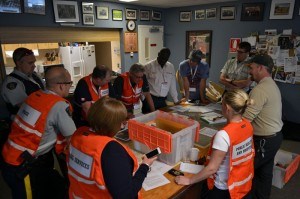
Representatives from a host of organizations gathered at Jasper’s Emergency Services Building, June 11, to take part in a simulation aimed at testing the town’s newly updated Municipal Emergency Response Plan.
Stew Walkinshaw ran the simulation. For the last six months he’s been working with Fire Chief Greg Van Tighem and the municipality to perfect the municipality’s plan, which exists to help the town coordinate its response during major emergencies.
That morning, the emergency response specialist went over the basics of the new plan with the group, outlining things like the function of the Incident Command Post, and the Emergency Response Guidelines.
After lunch, with the familiarization out of the way, Wilkinshaw stepped to the front of the room and laid out the emergency scenario that would unfold over the next couple of hours. The simulation would consist of a series of prompts, which the team would have to respond to according to the procedure laid out in the plan.
And with that short explanation he revealed the first prompt. A wildfire had sprung up beside Highway 16, just south of Whistlers Campground. It was moving towards town, and already spotting. The fire danger was extreme.
As the teams got organized, Wilkinshaw said that the main purpose of the simulation was to familiarize everyone with how the plan works in real time.
“The plan’s done, so really this is all about getting them familiar with how it’s implemented,” he said, as team members began getting into their bright coloured vests, designating their specific groups.
The vests come in five colours, with each designating a particular aspect of the management team. Van Tighem wore the green director vest, and his support staff wore red. In another corner of the room, the operations group sported bright orange. In yellow was the small logistics team, and in blue the planning section. The two-person finance group wore tan.
Wilkinshaw explained that although the groups were each responsible for a different aspect of the response, the idea is they all work together in a seamless way.
As the groups establish themselves, the sound of papers shuffling and the murmur of conversation filled the room. People poured over clipboards and flipped through binders. Occasionally someone from one group walked over to speak with someone from another.
The Municipal Emergency Management Plan exists to help the municipality deal with emergency situations in a streamlined way. It exists in several large, white binders that are organized with a series of colour-coordinated tabs. When an emergency happens, those binders provide the teams in the Command Post with a guideline for how to proceed.
And those guidelines are important because, in an emergency, representatives from several organizations will likely be part of the response. At the simulation, representatives from the Municipality of Jasper, Parks Canada, Alberta Health Services, Kinder Morgan and ATCO Electric were all present.
“The most important thing we’re trying to drive here is using the tools you have in your tool box—and that’s the Municipal Emergency Services Plan,” Wilkinshaw said. “Everybody’s got to work together, and everybody’s got different expertise.”
As the second prompt informed the teams that the fire had spread into Whistlers Campground, at the “Ops” table a group huddled around Parks’ fire and vegetation specialist Dave Smith, who outlined the fire’s probable course.
“Chances are the wind might pull it around this way, but more likely it will go this way—so I recommend we start thinking about here and here,” he said, gesturing to a map in his hand.
Alice Lettner, sporting the tan vest of the Finance Coordinator, circulated the room letting each group know what their spending limits were. Just as she finished her rounds, Van Tighem called a meeting of the heads of each section for an update.
A couple “hours” in and the fire had continued to creep toward town, still spotting significantly. The logistics operations coordinator told the group that, according to a specialists’ model, the fire would reach the town in less then three hours. The highways had been closed and an evacuation order for Cabin Creek and Stone Mountain had been given, with the Jasper Activity Centre acting as the evacuation site.
Van Tighem sent everyone back to their groups with orders to stick to the tasks laid out in the plan, and not get distracted by tangents.
Not long after that, the last prompt informed the group that rain had rolled in, and the fire had been controlled. Wilkinshaw held a quick debrief, and the teams began packing up.
“The biggest thing is just getting everybody together,” Van Tighem said, as he put away his vest.
The Municipal Emergency Management Plan is a living document, so it’s important to get all the concerned parties together every so often to make sure they are familiar with it, and that they can work together.
According to Christine Nadon, the municipality’s communications manager, the simulation is about “building competency within the organization.”
“It’s testing the plan, not the decisions. It’s really just about making sure everything runs smoothly.”
If a real emergency ever does spring up, she said she believes the team will be able to do just that.
Trevor Nichols
[email protected]
